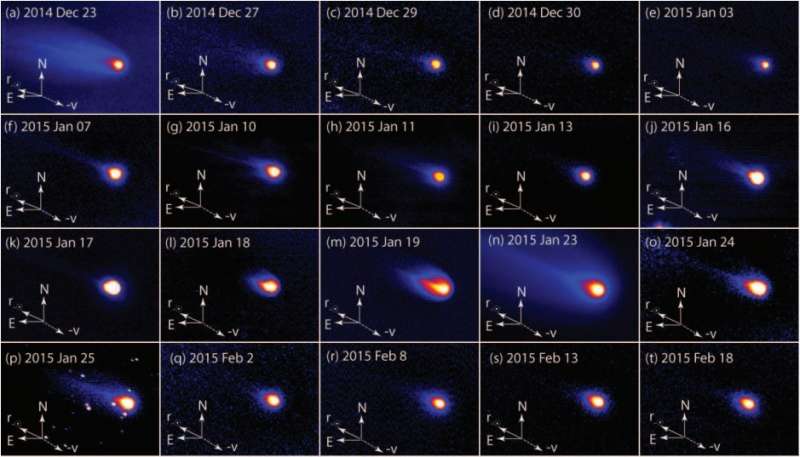September 7, 2016 report
Astronomers observe outburst of comet 15P/Finlay

(Phys.org)—A Jupiter-family comet, designated 15P/Finlay, has experienced two large-scale outbursts during its perihelion passage at the end of 2014 and the start of 2015. The latter was observed by a team of astronomers, led by Masateru Ishiguro of the Seoul National University in South Korea, offering a rare glimpse into the physical properties of cometary nuclei. The results of these observations are published Sept. 3 on the arXiv pre-print server.
15P/Finlay, discovered by William Henry Finlay in 1886, is a short-period comet with an orbital year of 6.5 years and a semi-major axis of nearly 3.5 AU. Its effective radius is estimated to be about 900 meters. The comet's perihelion passage in December 2014 at one AU from the sun was an excellent opportunity for astronomers to study its activity.
When 15P/Finlay experienced an outburst on Dec. 16, 2014, Ishiguro and his team decided to commence a three-month observational campaign of this comet with the aim of deepening the understanding of cometary outbursts. For this purpose, they employed six ground-based telescopes that are part of the Optical and Infrared Synergetic Telescopes for Education and Research (OISTER) inter-university observation network. Their efforts were fruitful and resulted in recording another outburst on January 15, 2015.
"We conducted an observation of the comet after the first outburst and subsequently witnessed another outburst on 2015 January 15.6–15.7," the researchers wrote in the paper.
The imagery taken by the team revealed a dramatic change in the comet's activity, starting with the picture acquired on January 16. The images show that the inner coma brightened on this day and dust ejecta appeared soon; afterward, they were stretched toward the anti-solar direction.
The astronomers also found that the appearance of the dust cloud on January 23 is similar to the image taken on December 23, in which the comet was enclosed by a widely expanded envelope. According to the team, this envelope dimmed quickly, leaving behind a near-nuclear dust cloud similar to that from the pre-second outburst.
The researchers estimated that during the January 15 outburst, gas consisting mostly of C2 and CN expanded at a speed of about 1,110 km s−1, which is slightly faster than the speeds of other comets at about 1 AU from the sun.
"The excess in speed can be explained by the large distance from the nucleus (about 100 million km), where the gas flow velocity continues to increase," the paper reads.
The study also reveals that during the blast, the dust ejecta accelerated up to a speed of 570 km s−1, which is comparable to the ejection speeds of two other outbursts similar comets.
"These consistent speeds would have resulted in the similar appearances of these outburst ejecta," the team noted.
The total mass of dust ejecta was calculated to be between 100,000 and one million metric tons.
Finally, based on their own observations complemented by previous studies on the nature of cometary outbursts, the scientists concluded that such turbulent events of 15P/Finlay and similar comets occur more than 1.5 times a year and inject dust particles into interplanetary space at a rate of approximately 10 kg s−1 or more.
More information: 2014-2015 Multiple Outbursts of 15P/Finlay, arXiv:1609.00792 [astro-ph.EP] arxiv.org/abs/1609.00792
Abstract
Multiple outbursts of a Jupiter-family comet, 15P/Finlay, occurred from late 2014 to early 2015. We conducted an observation of the comet after the first outburst and subsequently witnessed another outburst on 2015 January 15.6-15.7. The gas, consisting mostly of C2 and CN, and dust particles expanded at speeds of 1,110 +/- 180 m/s and 570 +/- 40 m/s at a heliocentric distance of 1.0 AU. We estimated the maximum ratio of solar radiation pressure with respect to the solar gravity beta_max = 1.6 +/- 0.2, which is consistent with porous dust particles composed of silicates and organics. We found that 10^8-10^9 kg of dust particles (assumed to be 0.3 micron - 1 mm) were ejected through each outburst. Although the total mass is three orders of magnitude smaller than that of the 17P/Holmes event observed in 2007, the kinetic energy per unit mass (104 J/kg) is equivalent to the estimated values of 17P/Holmes and 332P/2010 V1 (Ikeya-Murakami), suggesting that the outbursts were caused by a similar physical mechanism. From a survey of cometary outbursts on the basis of voluntary reports, we conjecture that 15P/Finlay-class outbursts occur >1.5 times annually and inject dust particles from Jupiter-family comets and Encke-type comets into interplanetary space at a rate of ~10 kg/s or more.
Journal information: arXiv
© 2016 Phys.org





















